NCERT Exemplar Solutions Class 10 Science Chapter 1 – Free PDF Download
NCERT Exemplar Class 10 Science Chapter 1 Chemical Reactions and Equations will help you understand all the fundamentals of chemical reactions as well as their symbolic representation in terms of equations. Here, students will learn to recognise chemical changes, write equations, classify chemical reactions and basically list a few examples of chemical reactions.
Thus, to help students get a clear idea about the chapter and the topics, we provide the free NCERT Exemplar for Class 10 Science Chapter 1 – Chemical Reactions and Equations PDF here. The exemplar is prepared by subject experts and is designed to help students get the right answers to questions and have a thorough revision of the entire chapter. The NCERT Exemplar act as a very useful study tool and will help students to perform well in the board exam.
Download the PDF of NCERT Exemplar for Class 10 Science Chapter 1 – Chemical Reactions and Equations
Access Answers to NCERT Exemplar for Class 10 Science Chapter 1 – Chemical Reactions and Equations
Multiple-choice Questions
1. Which of the following is not a physical change?
(a) Boiling of water to give water vapour
(b) Melting of ice to give water
(c) Dissolution of salt in water
(d) Combustion of Liquefied Petroleum Gas (LPG)
Soln:
Answer is (d) Combustion of Liquefied Petroleum Gas (LPG)
Explanation:
Combustion is always a chemical change because a new compound is formed after burning and it is irreversible.
2. The following reaction is an example of a:
4NH3 (g) + 5O2 (g) → 4NO(g) + 6H2O(g)
(i) displacement reaction
(ii) combination reaction
(iii) redox reaction
(iv) neutralisation reaction
(a) (i) and (iv)
(b) (ii) and (iii)
(c) (i) and (iii)
(d) (iii) and (iv)
Soln: (c) (i) and (iii)
Explanation:
The reaction provided is a mixture of displacement and redox reaction. Oxygen displaces hydrogen in the ammonia, making it a displacement reaction. Nitrogen gets oxidized and oxygen is reduced, resulting in a redox reaction.
3. Which of the following statements about the given reaction are correct?
3Fe(s) + 4H2O(g) → Fe3O4 (s) + 4H2 (g)
- Iron metal is getting oxidised
- Water is getting reduced
- Water is acting as a reducing agent
- Water is acting as an oxidising agent
(a) (i), (ii) and (iii)
(b) (iii) and (iv)
(c) (i), (ii) and (iv)
(d) (ii) and (iv)
Soln: (c) (i), (ii) and (iv)
Here, oxygen combines with water to get oxidised. Oxygen is removed from water hence, it is getting reduced. Water provides oxygen, and it acts as an oxidizing agent.
4. Which of the following are exothermic processes?
(i) The reaction of water with quick lime
(ii) Dilution of an acid
(iii) Evaporation of water
(iv) Sublimation of camphor (crystals)
(a) (i) and (ii)
(b) (ii) and (iii)
(c) (i) and (iv)
(d) (iii) and (iv)
Soln: (a) (i) and (ii)
Explanation:
The exothermic processes release an enormous amount of heat – Hence, heat energy is released when water reacts with quick lime and acid reacts with water.
5. Three beakers labelled as A, B and C each containing 25 mL of water were taken. A small amount of NaOH, anhydrous CuSO4 and NaCl were added to the beakers A, B and C, respectively. It was observed that there was an increase in the temperature of the solutions contained in beakers A and B, whereas, in the case of beaker C, the temperature of the solution falls. Which one of the following statement(s) is(are) correct?
(i) In beakers A and B, the exothermic process has occurred.
(ii) In beakers A and B, the endothermic process has occurred.
(iii) In beaker C exothermic process has occurred.
(iv) In beaker C endothermic process has occurred.
(a) (i) only
(b) (ii) only
(c) (i) and (iv)
(d) (ii) and (iii)
Soln:
Answer is (c) (i) and (iv)
Explanation:
Exothermic processes will increase the temperature whereas endothermic processes will decrease the temperature.
6. A dilute ferrous sulphate solution was gradually added to the beaker containing acidified permanganate solution. The light purple colour of the solution fades and finally disappears. Which of the following is the correct explanation for the observation?
(a) KMnO4 is an oxidising agent, it oxidises FeSO4
(b) FeSO4 acts as an oxidising agent and oxidises KMnO4
(c) The colour disappears due to dilution; no reaction is involved
(d) KMnO4 is an unstable compound and decomposes in the presence of FeSO4 to a colourless compound.
Soln: (a) KMnO4 is an oxidising agent, it oxidises FeSO4
Explanation:
In this reaction, potassium permanganate (KMnO4) is an oxidizing agent.
The solution is coloured purple because of the KMnO4 and it eventually disappears when all the KMnO4 in the solution is utilized.
7. Which among the following is(are) double displacement reaction(s)?
(i) Pb + CuCl2 → PbCl2 + Cu
(ii) Na2 SO4 + BaCl2 → BaSO4 + 2NaCl
(iii) C + O2 → CO2
(iv) CH4 + 2O2 → CO2 + 2H2O
(a) (i) and (iv)
(b) (ii) only
(c) (i) and (ii)
(d) (iii) and (iv)
Soln:
The answer is (b) (ii) only
Explanation:
Here, Sodium and Barium are displaced from each other’s salts, hence it is a double displacement reaction.
8. Which among the following statement(s) is (are) true? Exposure of silver chloride to sunlight for a long duration turns grey due to
(i) the formation of silver by decomposition of silver chloride
(ii) sublimation of silver chloride
(iii) decomposition of chlorine gas from silver chloride
(iv) oxidation of silver chloride
(a) (i) only
(b) (i) and (iii)
(c) (ii) and (iii)
(d) (iv) only
Soln:
Answer is (a) (i) only
9. Solid calcium oxide reacts vigorously with water to form calcium hydroxide accompanied by the liberation of heat. This process is called slaking of lime. Calcium hydroxide dissolves in water to form its solution called lime water. Which among the following is (are) true about slaking of lime and the solution formed?
(i) It is an endothermic reaction
(ii) It is an exothermic reaction
(iii) The pH of the resulting solution will be more than seven
(iv) The pH of the resulting solution will be less than seven
(a) (i) and (ii)
(b) (ii) and (iii)
(c) (i) and (iv)
(d) (iii) and (iv)
Soln:
The answer is (b) (ii) and (iii)
Explanation:
When solid calcium oxide reacts vigorously with water, it forms calcium hydroxide, which is accompanied by the generation of heat. This event proves the reaction is exothermic. The pH of the solution will be more than 7 because oxides and hydroxides of metals are alkaline.
10. Barium chloride, on reacting with ammonium sulphate, forms barium sulphate and ammonium chloride. Which of the following correctly represents the type of reaction involved?
(i) Displacement reaction
(ii) Precipitation reaction
(iii) Combination reaction
(iv) Double displacement reaction
(a) (i) only
(b) (ii) only
(c) (iv) only
(d) (ii) and (iv)
Soln:
Answer is (d) (ii) and (iv)
Explanation:
Ammonium and barium are getting displaced from their respective salts. Hence this is a double displacement reaction. It is also called a precipitation reaction due to the formation of white precipitate of barium sulphate.
11. Electrolysis of water is a decomposition reaction. The mole ratio of hydrogen and oxygen gases liberated during electrolysis of water is
(a) 1:1
(b) 2:1
(c) 4:1
(d) 1:2
Soln:
Answer is (b) 2:1
Explanation:
1 Mole of water has 2 moles of Hydrogen and 1 mole of water. Hence mole ration between hydrogen and oxygen is 2:1.
12. Which of the following is(are) an endothermic process(es)?
(i) Dilution of sulphuric acid
(ii) Sublimation of dry ice
(iii) Condensation of water vapours
(iv) Evaporation of water
(a) (i) and (iii)
(b) (ii) only (c)
(iii) only
(d) (ii) and (iv)
Soln:
Answer is (d) (ii) and (iv)
Explanation:
Change of solid to gas or liquid to gas absorbs heat hence sublimation of dry ice and evaporation is an endothermic reaction.
13. In the double displacement reaction between aqueous potassium iodide and aqueous lead nitrate, a yellow precipitate of lead iodide is formed. While performing the activity, if lead nitrate is not available, which of the following can be used in place of lead nitrate?
(a) Lead sulphate (insoluble)
(b) Lead acetate
(c) Ammonium nitrate
(d) Potassium sulphate
Soln:
The answer is (b) Lead acetate
Explanation:
To get lead iodide we need a compound containing lead hence Ammonium nitrate and Potassium sulphate are ruled out. Lead sulphate is insoluble hence it cannot be used so the answer is (b) Lead acetate
14. Which of the following gases can be used for storage of fresh sample of an oil for a long time?
(a) Carbon dioxide or oxygen
(b) Nitrogen or oxygen
(c) Carbon dioxide or helium
(d) Helium or nitrogen
Soln:
The answer is (d) Helium or nitrogen
Explanation:
Oxygen cannot be used as it is an oxidizing agent. Helium can be used as it is an inert gas. Nitrogen is less reactive and it is cheaper than Helium. In most cases, nitrogen is used in packet to prevent rancidity.
15. The following reaction is used for the preparation of oxygen gas in the laboratory
Which of the following statement(s) is(are) correct about the reaction?
(a) It is a decomposition reaction and endothermic in nature
(b) It is a combination reaction
(c) It is a decomposition reaction and accompanied by the release of heat
(d) It is a photochemical decomposition reaction and exothermic in nature
Soln:
Answer is (a) It is a decomposition reaction and endothermic in nature
Explanation:
Potassium chlorate decomposes to give potassium chloride and oxygen. This is a decomposition reaction which is endothermic in nature.
16. Which one of the following processes involves chemical reactions?
(a) Storing of oxygen gas under pressure in a gas cylinder
(b) Liquefaction of air
(c) Keeping petrol in a china dish in the open
(d) Heating copper wire in the presence of air at high temperature
Soln:
The answer is (d) Heating copper wire in the presence of air at a high temperature
Explanation :
In first three options given here, there is no involvement of chemical reaction. When copper is heated in the presence of air at high-temperature copper undergoes oxidation reaction to give out copper oxide.
17. In which of the following chemical equations, the abbreviations represent the correct states of the reactants and products involved at reaction temperature?
a.
b.
c.
d.
Soln:
Answer is (c):
Explanation:
At room temperature hydrogen and oxygen are gases while water is liquid in nature hence option c) represents correct states of reactants and products.
18. Which of the following are combination reactions?
- \(\begin{array}{l}2 \mathrm{KClO} 3 \stackrel{\text { heat }}{\longrightarrow} 2 \mathrm{KCl}+30_{2}\end{array} \)
- \(\begin{array}{l}\mathrm{MgO}+\mathrm{H}_{2} \mathrm{O} \longrightarrow \mathrm{Mg}(\mathrm{OH})_{2}\end{array} \)
- \(\begin{array}{l}4 \mathrm{Al}+3 \mathrm{O}_{2} \longrightarrow 2 \mathrm{Al}_{2} \mathrm{O}_{3}\end{array} \)
- \(\begin{array}{l}\mathrm{Zn}+\mathrm{FeSO}_{4} \longrightarrow \mathrm{ZnSO}_{4}+\mathrm{Fe}\end{array} \)
(a) (i) and (iii)
(b) (iii) and (iv)
(c) (ii) and (iv)
(d) (ii) and (iii)
Soln:
Answer is (d) (ii) and (iii)
Explanation:
Here, two reactants react to form a single product hence option ii) and iii) represents combination reactions
Short Answer Questions
19. Write the balanced chemical equations for the following reactions and identify the type of reaction in each case.
(a) Nitrogen gas is treated with hydrogen gas in the presence of a catalyst at 773K to form ammonia gas.
(b) Sodium hydroxide solution is treated with acetic acid to form sodium acetate and water.
(c) Ethanol is warmed with ethanoic acid to form ethyl acetate in the presence of concentrated H2 SO4.
(d) Ethene is burnt in the presence of oxygen to form carbon dioxide, water and releases heat and light.
Soln:
(a)
Option (a) is a combination reaction.
(b)
Option (b) is a neutralisation reaction between a strong base and a weak acid.
(c)
Option (c) is a neutralisation reaction and double displacement reaction.
(d)
Option (d) is an example of an oxidation reaction.
20. Write the balanced chemical equations for the following reactions and identify the type of reaction in each case.
(a) Thermite reaction, iron (III) oxide reacts with aluminium and gives molten iron and aluminium oxide.
(b) Magnesium ribbon is burnt in an atmosphere of nitrogen gas to form solid magnesium nitride.
(c) Chlorine gas is passed in an aqueous potassium iodide solution to form potassium chloride solution and solid iodine.
(d) Ethanol is burnt in air to form carbon dioxide, water and releases heat.
Soln:
(a) Thermit reaction, iron (III) oxide reacts with aluminium and gives molten iron and aluminium oxide.
FE2O3 + 2Al → Al2O3(s)+ 2Fe (l)
This is a Single displacement reaction
(b) Magnesium ribbon is burnt in an atmosphere of nitrogen gas to form solid magnesium nitride.
3 Mg(s)+ N2 → Mg3N2
The reaction is a Combination reaction
(c) Chlorine gas is passed in an aqueous potassium iodide solution to form potassium chloride solution and solid iodine.
Cl2(g)+2KI (aq) → 2KCl(Aq) +I2(s)
This is a Single displacement reaction
(d) Ethanol is burnt in air to form carbon dioxide, water and releases heat.
C2H5OH+ 3O2 → 2CO2+ 3H2O+ heat
This is a Combustion reaction
21. Complete the missing components/variables given as x and y in the following reactions
(a) Pb(NO3 ) 2 (aq) + 2KI(aq) → PbI2 (x) + 2KNO3 (y)
(b) Cu(s) + 2Ag NO3 (aq) → Cu(NO3 ) 2 (aq) + x(s)
(c) Zn(s) + H2 SO4 (aq) → ZnSO4 (x) + H2 (y)
(d) CaCO3 (s) →x CaO(s) + CO2 (g)
Soln:
(a) Pb(NO3 ) 2 (aq) + 2KI(aq) → PbI2 (s) + 2KNO3 (aq)
(b) Cu(s) + 2Ag NO3 (aq) → Cu(NO3 ) 2 (aq) + 2Ag(s)
(c) Zn(s) + H2 SO4 (aq) → ZnSO4 (aq) + H2 (g)
(d) CaCO3 (s) →heat→ CaO(s) + CO2 (g)
- x(s), y (aq)
- x is 2Ag
- x-(aq) y(g)
- x is heat
22. Which among the following changes are exothermic or endothermic in nature?
(a) Decomposition of ferrous sulphate
(b) Dilution of sulphuric acid
(c) Dissolution of sodium hydroxide in water
(d) Dissolution of ammonium chloride in water
Soln:
Exothermic reactions
(b) Dilution of sulphuric acid
(c) Dissolution of sodium hydroxide in water
Endothermic reaction
a) Decomposition of ferrous sulphate
(d) Dissolution of ammonium chloride in water
23. Identify the reducing agent in the following reactions
(a) 4NH3 + 5O2 → 4NO + 6H2O
(b) H2O + F2 → HF + HOF
(c) Fe2O3 + 3CO → 2Fe + 3CO2
(d) 2H2 + O2 → 2H2O
Soln:
- NH3-Ammonia
- H2O – Water
- CO-Carbon momnoxide
- H2- Hydrogen
24. Identify the oxidising agent (oxidant) in the following reactions
(a) Pb3O4 + 8HCl → 3PbCl2 + Cl2 + 4H2O
(b) 2Mg + O2 → 2MgO
(c) CuSO4 + Zn → Cu + ZnSO4
(d) V2O5 + 5Ca → 2V + 5CaO
(e) 3Fe + 4H2O → Fe3O4 + 4H2
(f) CuO + H2 → Cu + H2O
Soln:
- Pb3O4
- O2
- CuSO4
- V2O5
- H2O
- CuO
25. Write the balanced chemical equations for the following reactions
(a) Sodium carbonate on reaction with hydrochloric acid in equal molar concentrations gives sodium chloride and sodium hydrogen carbonate.
(b) Sodium hydrogen carbonate on reaction with hydrochloric acid gives sodium chloride, water and liberates carbon dioxide.
(c) Copper sulphate on treatment with potassium iodide precipitates cuprous iodide (Cu2 I2 ), liberates iodine gas and also forms potassium sulphate.
Soln:
(a) Na2CO3 + HCl → NaCl + NaHCO3
(b) NaHCO3 + HCl → NaCl + H2O + CO2
(c) 2CuSO4+4Kl →2K2SO4+CU2I2+I2
26. A solution of potassium chloride when mixed with silver nitrate solution, an insoluble white substance is formed. Write the chemical reaction involved and also mention the type of chemical reaction?
Soln:
KCl(aq) + AgNO3(aq) → AgCl(s) + KNO3(aq)
This is a double displacement and precipitation reaction.
27. Ferrous sulphate decomposes with the evolution of a gas having a characteristic odour of burning sulphur. Write the chemical reaction involved and identify the type of reaction.
Soln
2FeSO4=Fe2O3+SO2+SO3
This is a decomposition reaction.
28. Why do fireflies glow at night?
Soln:
Fireflies produce a chemical reaction inside their bodies which allows them to glow at night. Oxygen combines with calcium, ATP and luciferin in the presence of an enzyme called luciferase. This results in bioluminescence.
29. Grapes hanging on the plant do not ferment but after being plucked from the plant can be fermented. Under what conditions do these grapes ferment? Is it a chemical or a physical change?
Soln:
Grapes on the plant do not ferment because of the defence mechanism of plants. When grapes are plucked from the plant, grapes react with yeast to carry out fermentation. Here, sugar changes to alcohol and it is a chemical change.
30. Which among the following are physical or chemical changes?
(a) Evaporation of petrol
(b) Burning of Liquefied Petroleum Gas (LPG)
(c) Heating of an iron rod to red hot.
(d) Curdling of milk
(e) Sublimation of solid ammonium chloride
Soln:
Physical changes
- Evaporation of petrol
- Heating of an iron rod to red hot.
- Sublimation of solid ammonium chloride
Chemical changes
- Burning of Liquefied Petroleum Gas (LPG)
- (d) Curdling of milk
31. During the reaction of some metals with dilute hydrochloric acid, the following observations were made.
(a) Silver metal does not show any change
(b) The temperature of the reaction mixture rises when aluminium (Al) is added.
(c) The reaction of sodium metal is found to be highly explosive
- Some bubbles of gas are seen when lead (Pb) is reacted with the acid.
Explain these observations giving suitable reasons.
Soln:
- There will not be any reaction between silver and dilute HCL as silver lies in low reactive series of metals.
- Because it is an exothermic reaction temperature increases
- Sodium is highly reactive metals it reacts with atmospheric oxygen to form exothermic reaction which results in temperature increase.
- When lead reacts with acid it produces Hydrogen gas which is responsible for the formation of bubbles.
32. A substance X, which is an oxide of a group 2 element, is used intensively in the cement industry. This element is present in bones also. On treatment with water, it forms a solution which turns red litmus blue. Identify X and also write the chemical reactions involved.
Soln:
Compound X is Calcium oxide. CaO is extensively used in the cement industry. On treatment with water, CaO produces Ca(OH)2 which is alkaline in nature and turns red litmus to blue colour.
Ca +H2O→ Ca(OH)2
33. Write a balanced chemical equation for each of the following reactions and also classify them.
(a) Lead acetate solution is treated with dilute hydrochloric acid to form lead chloride and acetic acid solution.
(b) A piece of sodium metal is added to absolute ethanol to form sodium ethoxide and hydrogen gas.
(c) Iron (III) oxide on heating with carbon monoxide gas reacts to form solid iron and liberates carbon dioxide gas.
(d) Hydrogen sulphide gas reacts with oxygen gas to form solid sulphur and liquid water.
Soln:
(a) Pb(CH3COO)2 + 2HCI – PbCl2 + CH3COOH
This is a Double Displacement reaction.
(b) 2Na + 2C2H5OH + 2C2H5ONa+ H2
This is a Displacement reaction.
(c) Fe2O3 + 3CO + 2Fe + 3CO2
This is a redox reaction.
(d) 2 H2S+O2 → 2 s + 2 H2O
This is a replacement reaction.
34. Why do we store silver chloride in dark coloured bottles?
Soln:
Silver chloride decomposes into silver and chlorine gas when exposed to sunlight. Hence Silver chloride is stored in dark coloured bottles.
35. Balance the following chemical equations and identify the type of chemical reaction.
(a) Mg(s) + Cl2 (g) → MgCl2 (s)
(b) HgO(s) → Heat Hg(l) + O2 (g)
(c) Na(s) + S(s) → Fuse Na2S(s)
(d) TiCl4 (l) + Mg(s) → Ti(s) + MgCl2 (s)
(e) CaO(s) + SiO2 (s) → CaSiO3 (s)
(f) H2O2 (l) → U V H2O(l) + O2 (g)
Soln:
(a) Mg(s) + Cl2(g) → MgCl2(s)
This type of reaction is called a combination reaction or a synthesis reaction.
(b) 2HgOis) — (Heat) → 2 Hg(I) + O2(g)
This is an example of thermal decomposition reaction.
(c) 2Na(s) + S(s) — (Fuse) → Na2S(s)
This is an example of a Combination reaction.
(d) TiCI4 (1) + Mg(s) → Ti(s) + 2MgCl2 (s)
This reaction falls under the category of Displacement reactions
(e) Cao(s) + SIO2(s) + CaSIO3(s)
This is a synthesis reaction.
(f) 2H2O2 (I) — UV → 2H2O(I) + O2 (g)
This is a decomposition reaction.
36. A magnesium ribbon is burnt in oxygen to give a white compound X accompanied by emission of light. If the burning ribbon is now placed in an atmosphere of nitrogen, it continues to burn and forms a compound Y.
(a) Write the chemical formulae of X and Y.
(b) Write a balanced chemical equation, when X is dissolved in water.
Soln:
2Mg + O₂ →2MgO
Compound X→ MgO [ Magnesium Oxide ]
Compound Y →Mg₃N₂ [ Magnesium Nitride ]
If Magnesium Oxide is dissolved in water, the product is Magnesium Hydroxide
MgO + H₂O → Mg(OH)₂
37. Zinc liberates hydrogen gas when reacted with dilute hydrochloric acid, whereas copper does not. Explain why?
Soln:
Zinc is more reactive than copper as Zinc is placed above Hydrogen and Copper is placed below hydrogen in the activity series of metals. Because of this Zinc reacts with HCl whereas Copper will not react.
38. A silver article generally turns black when kept in the open for a few days. The article when rubbed with toothpaste again starts shining. (a) Why do silver articles turn black when kept in the open for a few days? Name the phenomenon involved. (b) Name the black substance formed and give its chemical formula.
Soln:
- Silver reacts with H2S present in the atmosphere to form a black colour compound Silver Sulphide. This phenomenon is called corrosion.
- The black colour compound formed is Silver Sulphide
2Ag+ H2S →Ag2S+H2
Long Answer Questions
39. On heating blue coloured powder of copper (II) nitrate in a boiling tube, copper oxide (black), oxygen gas and a brown gas X is formed
(a) Write a balanced chemical equation of the reaction.
(b) Identity the brown gas X evolved.
(c) Identify the type of reaction.
(d) What could be the pH range of aqueous solution of the gas X?
Soln:
(a)

(b) The brown gas X is nitrogen dioxide, NO2.
(c) The reaction involved is Thermal decomposition.
(d) pH< 7 because NO2 dissolves in water to form acidic solution (pH range below 7).
40. Give the characteristic tests for the following gases
(a) CO2
(b) SO2
(c) O2
(d) H2
Soln:
- Pass CO2 into limewater which will turn water into milky. This is the confirmation test for the presence of Carbon-di-oxide.
- The smell is the characteristic feature of SO2, which smells like a rotten egg.
- Test for oxygen involves burning of match stick near oxygen makes it burn even more brightly.
- When a burning matchstick is brought near H2 gas, the flame burns with the pop sound. This is the test to confirm Hydrogen gas.
41. What happens when a piece of
(a) zinc metal is added to copper sulphate solution?
(b) aluminium metal is added to dilute hydrochloric acid?
(c) silver metal is added to copper sulphate solution?
Also, write the balanced chemical equation if the reaction occurs
Soln:
a) When Zinc is added to copper sulphate solution Zinc displaces copper to form Zinc sulphate.
Zn(s)+ CuSo4(aq)→ ZnSo4(aq)+ Cu(s)
b)Aluminium metals react with dilute HCl to form Aluminum Chloride and Hydrogen gas is evolved in the reaction.
2Al (s)+ 6HCl(aq)→ 2AlCl3(aq)+ 3 H2
c)When silver metal is added to Copper Sulphate solution there will not be any reaction as silver is non-reactive metal.
42. What happens when zinc granules are treated with a dilute solution of H2SO4, HCl, HNO3, NaCl and NaOH, also write the chemical equations if a reaction occurs.
Soln:
When Zinc granules react with dil H2SO4 displacement reaction takes place leading to the formation of ZnSo4 liberating H2 gas
Zn( s)+ H2SO4(aq)→ ZnSo4 (aq)+H2 (g)
When Zinc granules react with dil HCl displacement reaction takes place leading to the formation of ZnCl2 liberating H2 gas
Zn( s)+ H2Cl(aq) →ZnCl2 (aq)+H2 (g)
When Zinc granules react with dil HNO3 it leads to the formation of Zinc nitrate evolving H2O and nitrous oxide
4Zn(s)+10 HNO3(aq) 4Zn(NO3)2(aq) +5H2O(i)+N2O (g)
When Zinc granules react with NaCl there will not be any reaction
When Zinc granules react with NaOH solution
Zn(s)+ NaOH(aq)→ Na2ZnO2 (aq)+H2 (g)
43. On adding a drop of barium chloride solution to an aqueous solution of sodium sulphite, a white precipitate is obtained.
(a) Write a balanced chemical equation of the reaction involved
(b) What other names can be given to this precipitation reaction?
(c) On adding dilute hydrochloric acid to the reaction mixture, white precipitate disappears. Why?
Soln:
a)On adding a drop of Barium Chloride solution to an aqueous solution of sodium sulphite, barium sulphite is obtained which is white colour precipitate.
BaCl2 + Na2SO3——>BaSO3 + 2NaCl
b) In this case, the precipitation reaction is a double displacement.
c) When we add dilute HCl to this reaction mixture Barium chloride, Sulphur dioxide and water are formed. Barium chloride is a soluble substance which will make the white precipitate disappear.
BaSO3 + HCl→ BaCl3 + SO2 + H2O.
44. You are provided with two containers made up of copper and aluminium. You are also provided with solutions of dilute HCl, dilute HNO3, ZnCl2 and H2O. In which of the above containers can these solutions be kept?
These solutions can be kept in a copper container because copper is a noble metal which will not react with HCl or even HNO3. If we keep the solution in an aluminium container, aluminium reacts with acids to form Zinc chloride.
Water can be stored in either copper or aluminium as they both do not react with copper.
| Also Access |
| NCERT Solutions for Class 10 Science Chapter 1 |
| CBSE Notes for Class 10 Science Chapter 1 |
NCERT Exemplar Class 10 Science Chemical Reactions
The NCERT Exemplar Solutions for Class 10 Science Chapter 1, Chemical Reactions and Equations, contain all types of questions, which include MCQs, fill in the blanks, match the following, etc. Chemical reactions are a very fundamental topic, which will help students in their future studies. Hence, they are advised to study this chapter thoroughly.
Important Topics of Class 10 Chapter 1 Science Chemical Reactions and Equations
| Section Number | Topic |
| 1.1 | Chemical Equations |
| 1.1.1 | Writing a Chemical Equation |
| 1.1.2 | Balanced Chemical Equations |
| 1.2 | Types of Chemical Reactions |
| 1.2.1 | Combination Reaction |
| 1.2.2 | Decomposition Reaction |
| 1.2.3 | Displacement Reaction |
| 1.2.4 | Double Displacement Reaction |
| 1.3 | Have You Observed the Effects of Oxidation Reactions in Everyday Life? |
| 1.3.1 | Corrosion |
| 1.3.2 | Rancidity |
Students are also advised to solve the CBSE previous years’ question papers as well as the sample papers. Solving the sample papers and CBSE previous year papers will help them to get familiar with the exam pattern as well as the marking scheme.
Frequently Asked Questions on NCERT Exemplar Solutions for Class 10 Science Chapter 1
Explain the term rancidity covered in Chapter 1 of NCERT Exemplar Solutions for Class 10 Science.
How many questions are present in NCERT Exemplar Solutions for Class 10 Science Chapter 1?
Are the NCERT Exemplar Solutions for Class 10 Science Chapter 1 sufficient for the exam preparation?
Also, Read

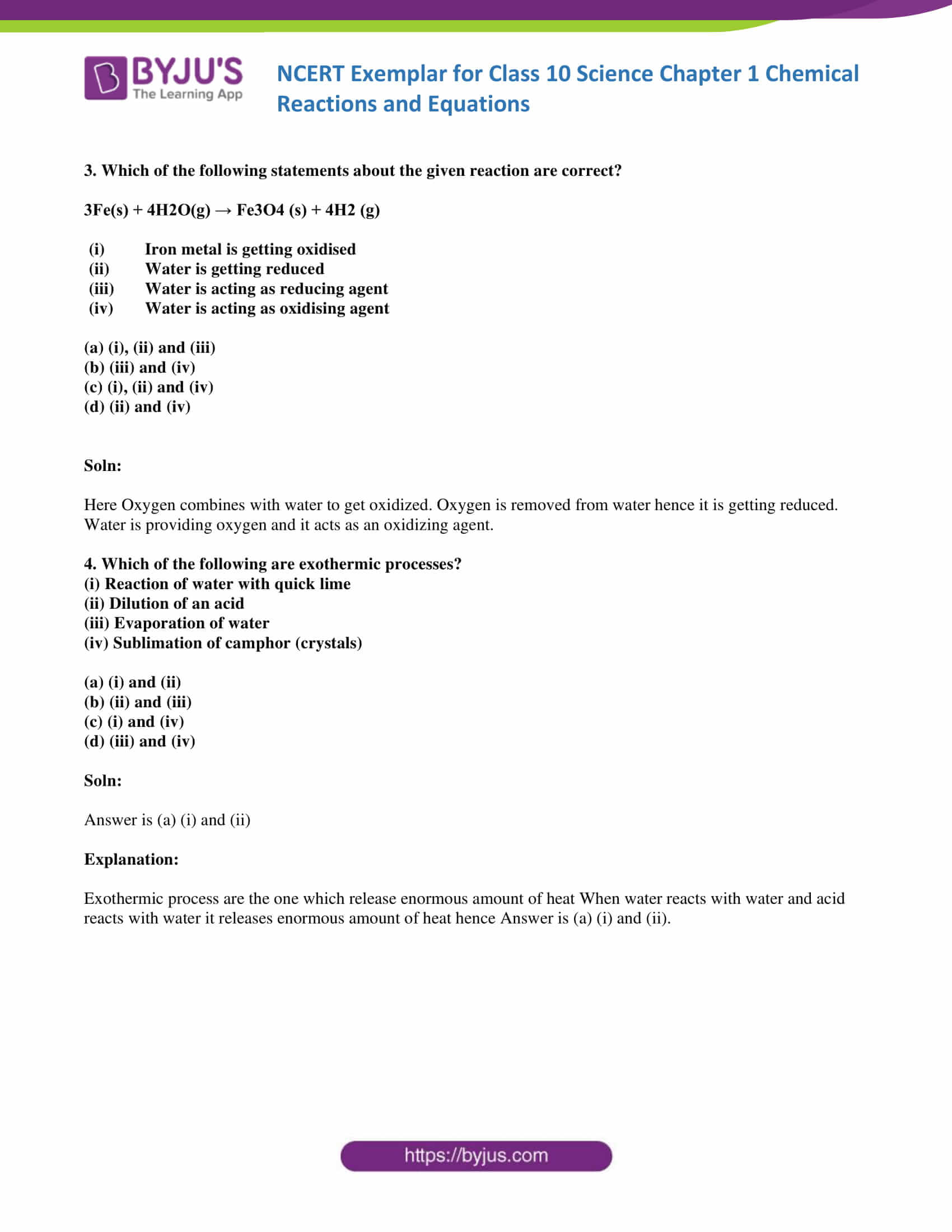
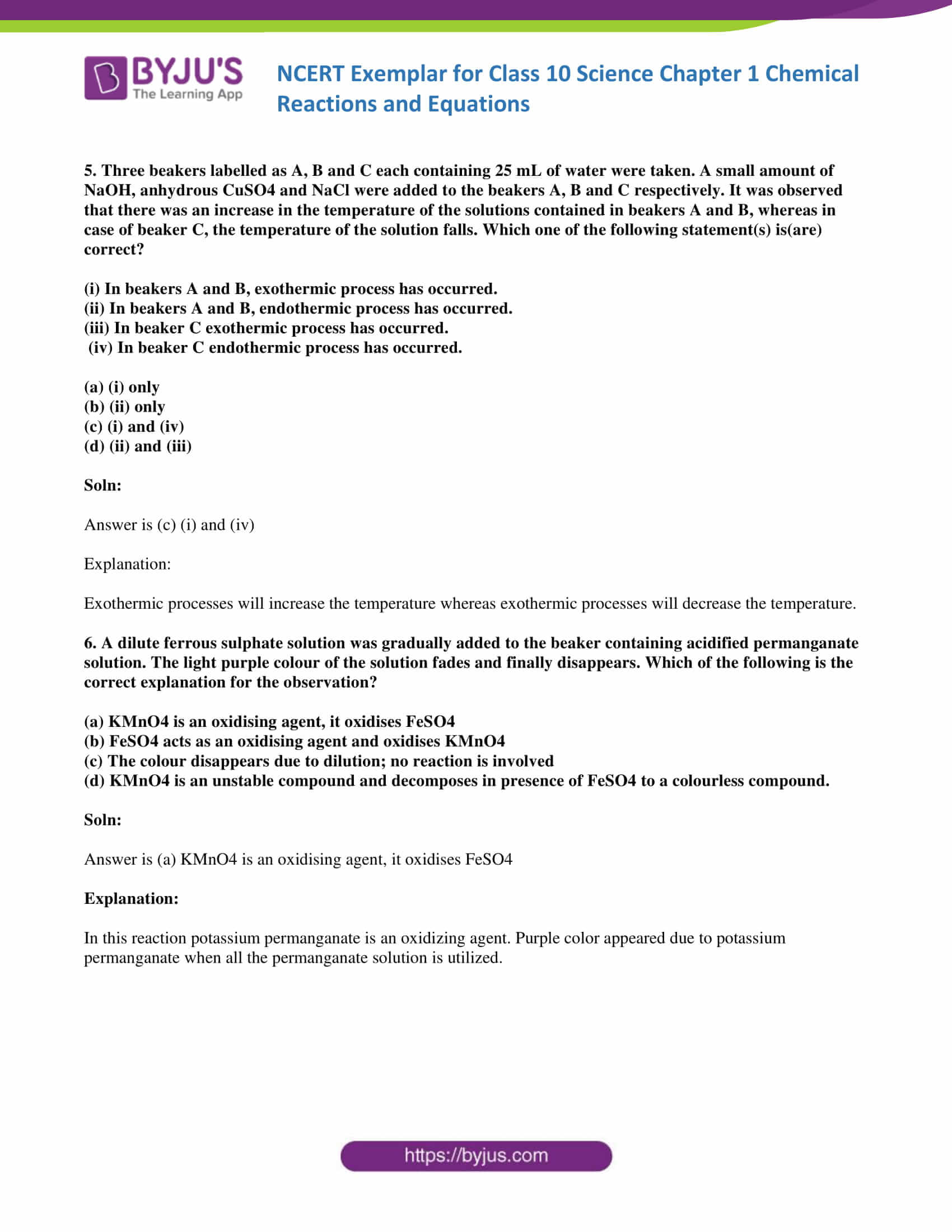

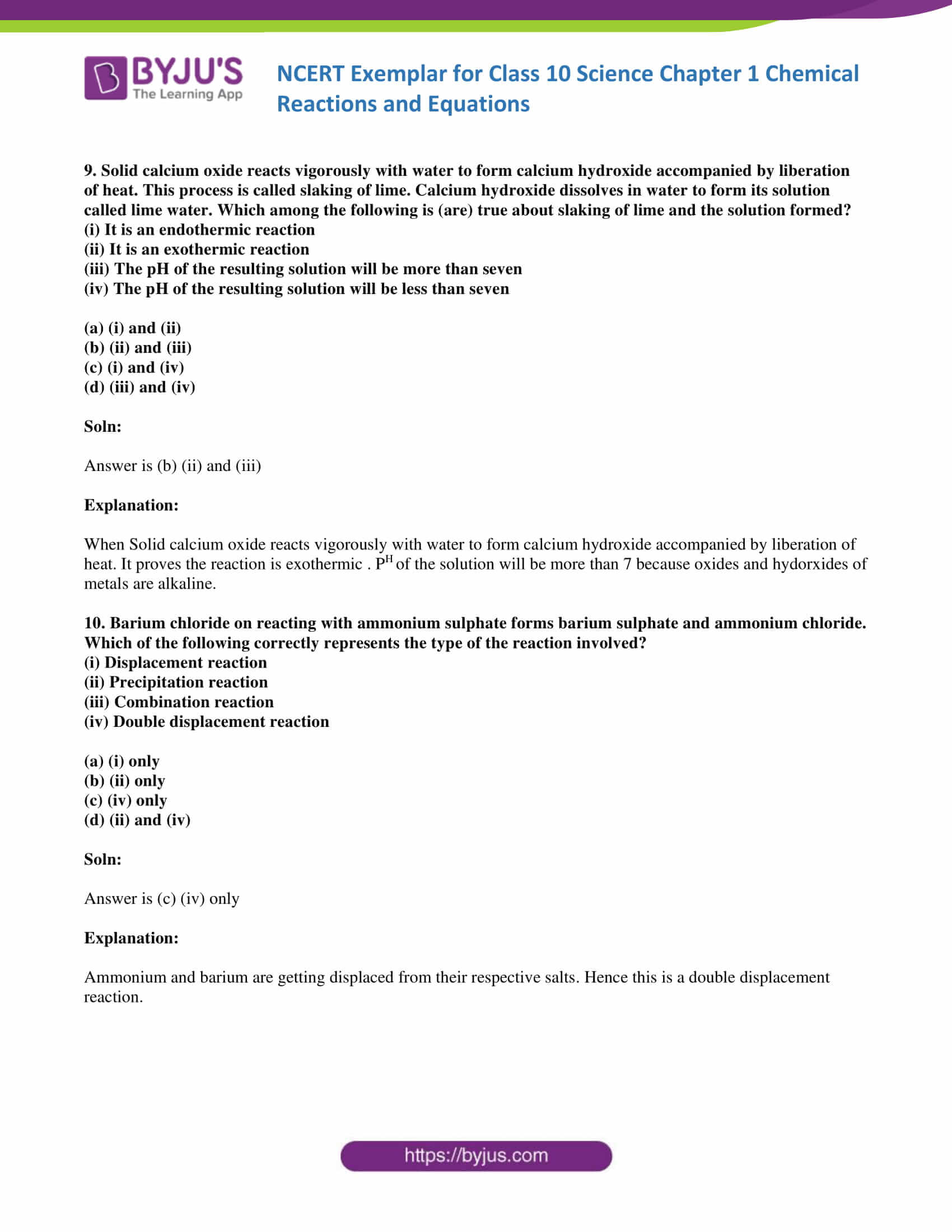

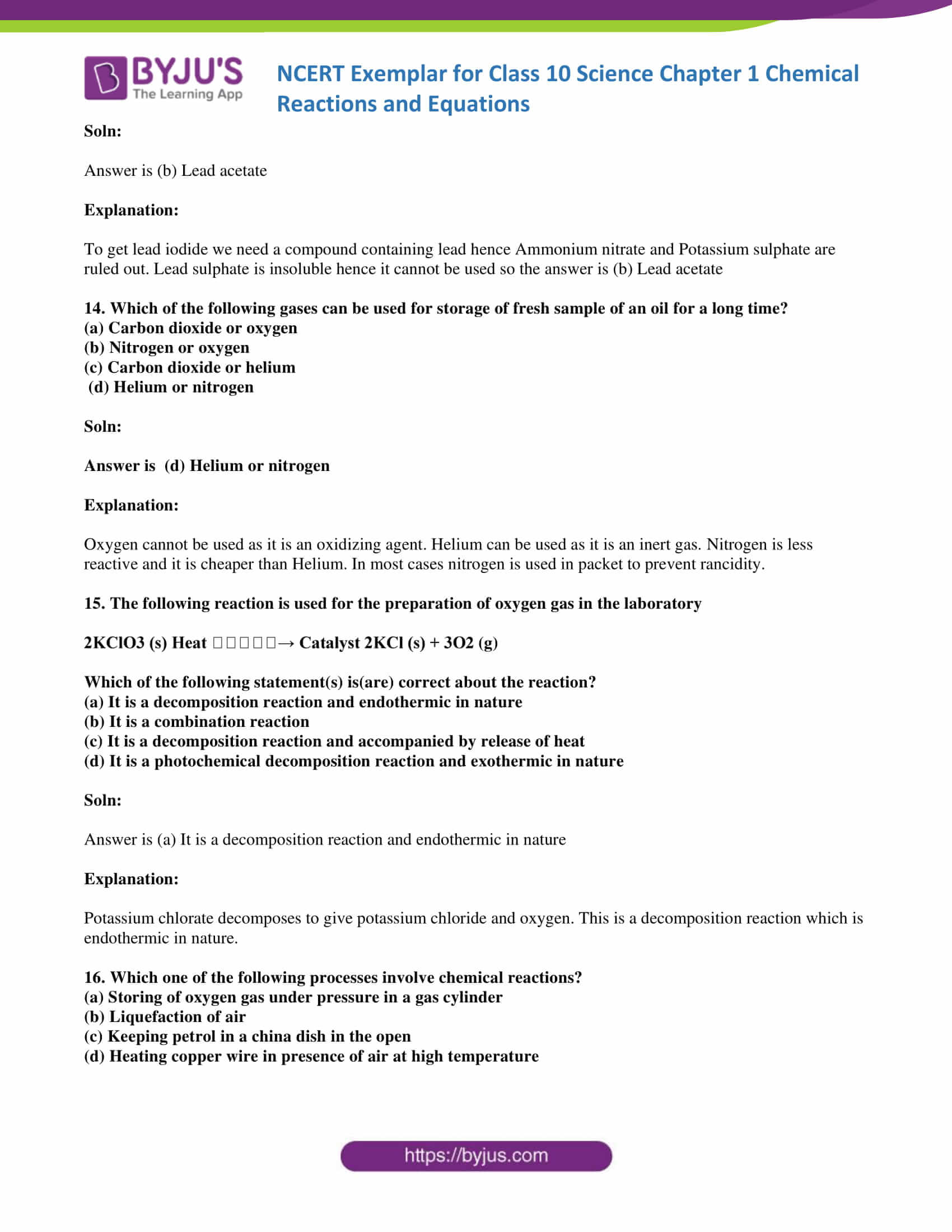
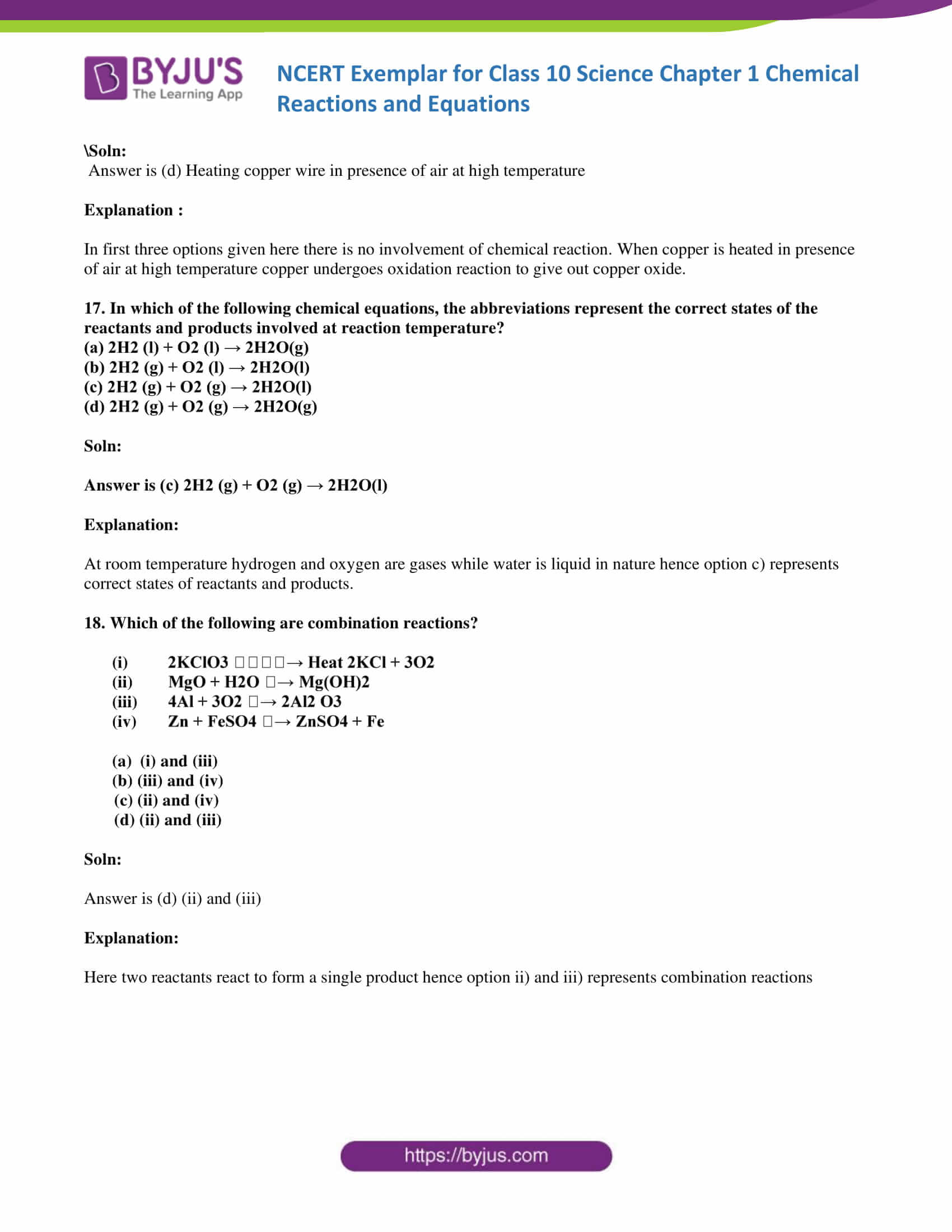


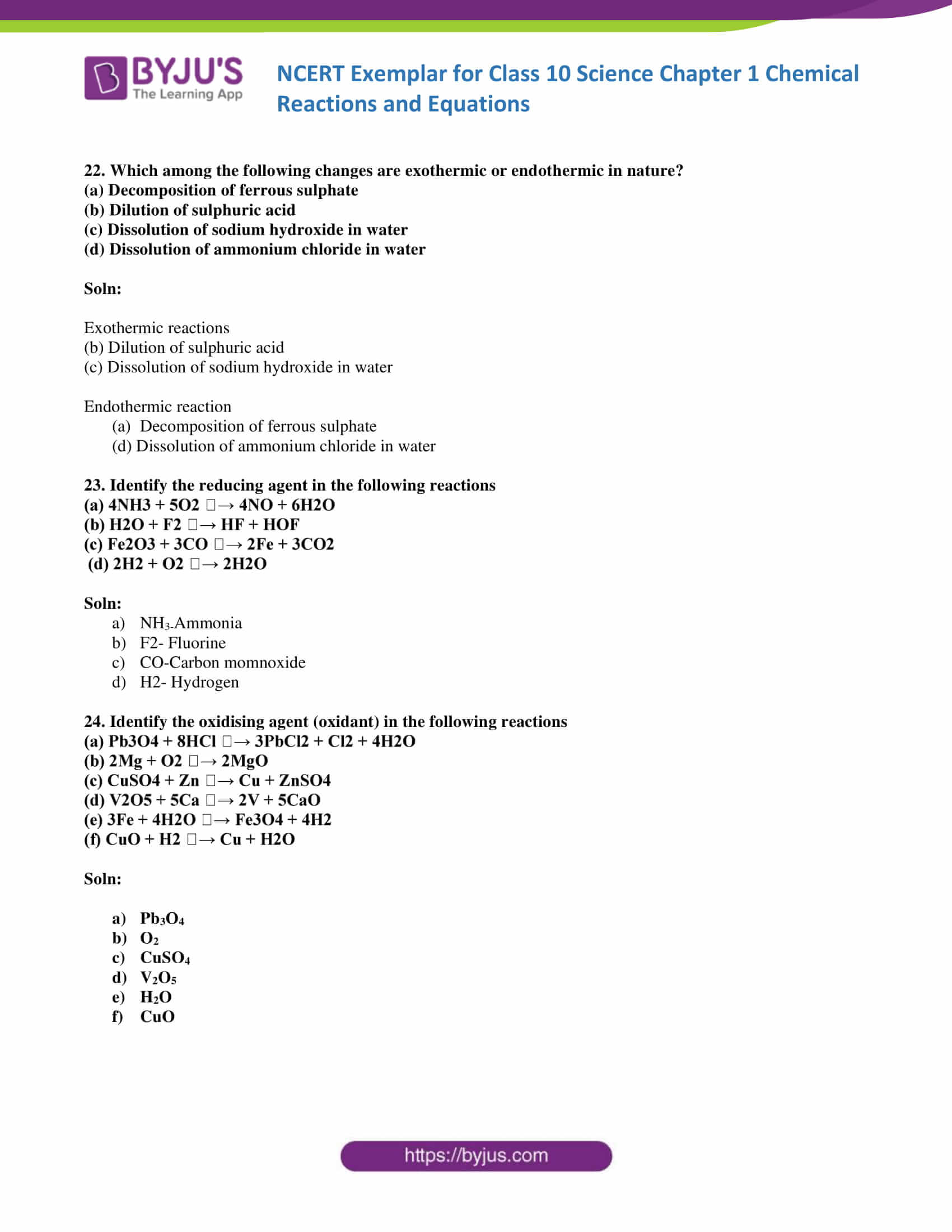

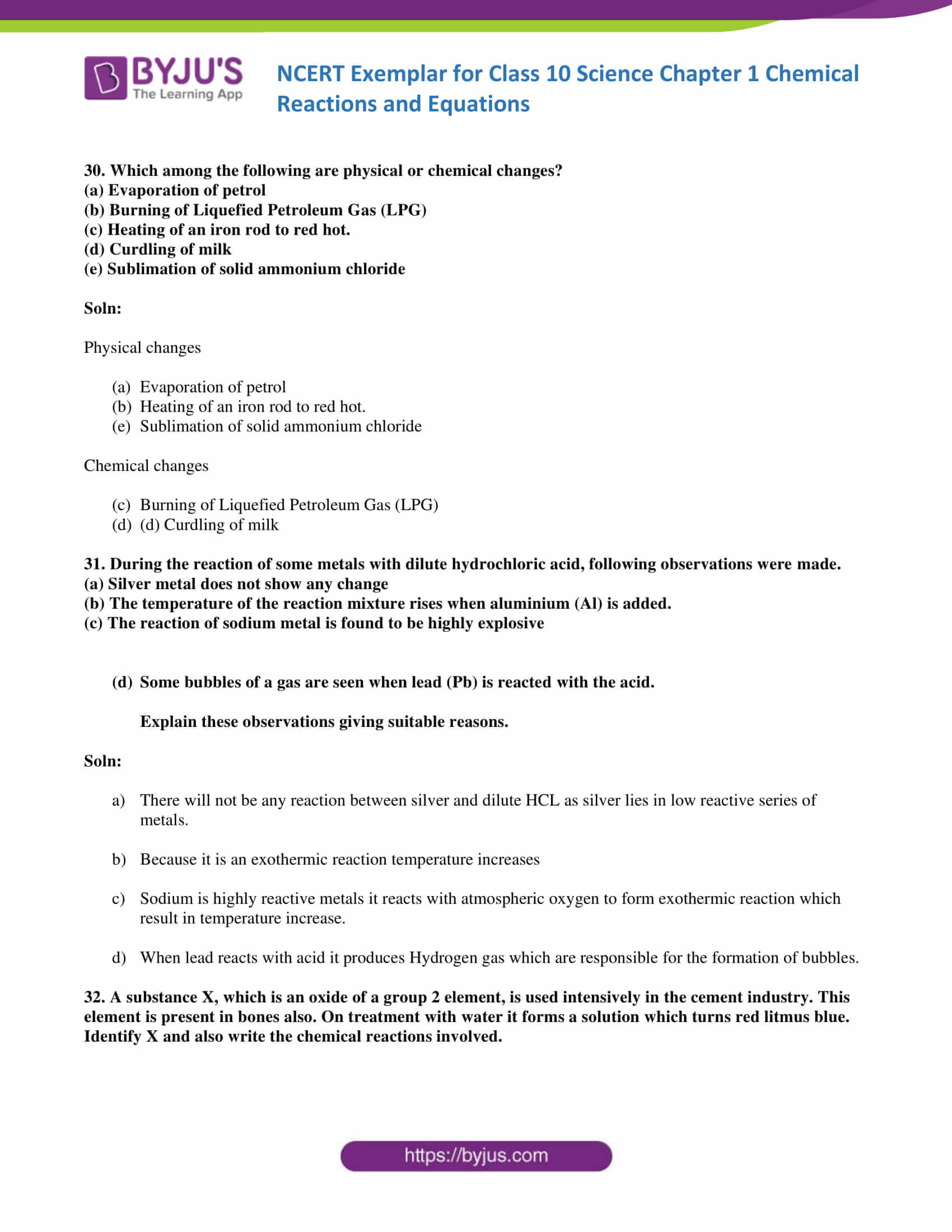
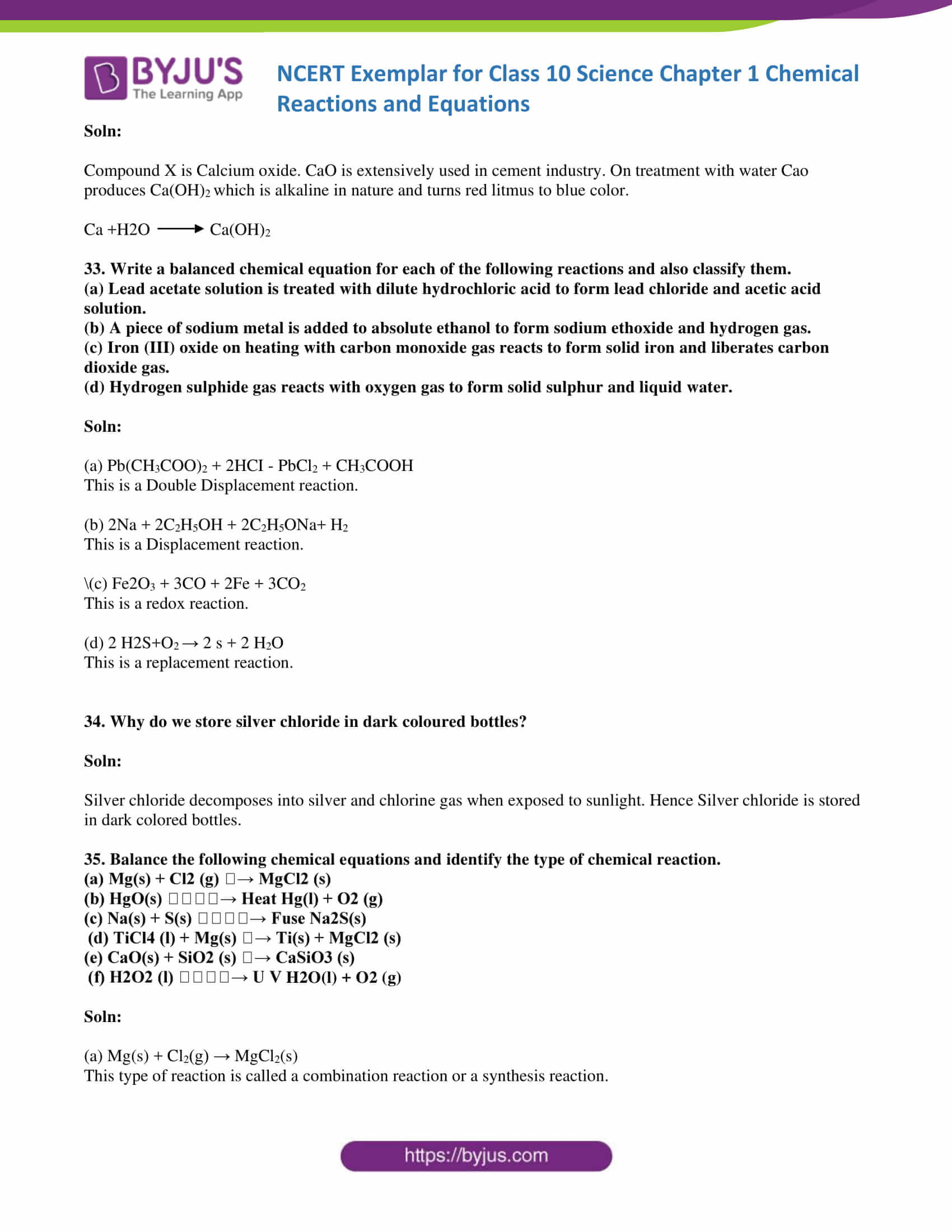
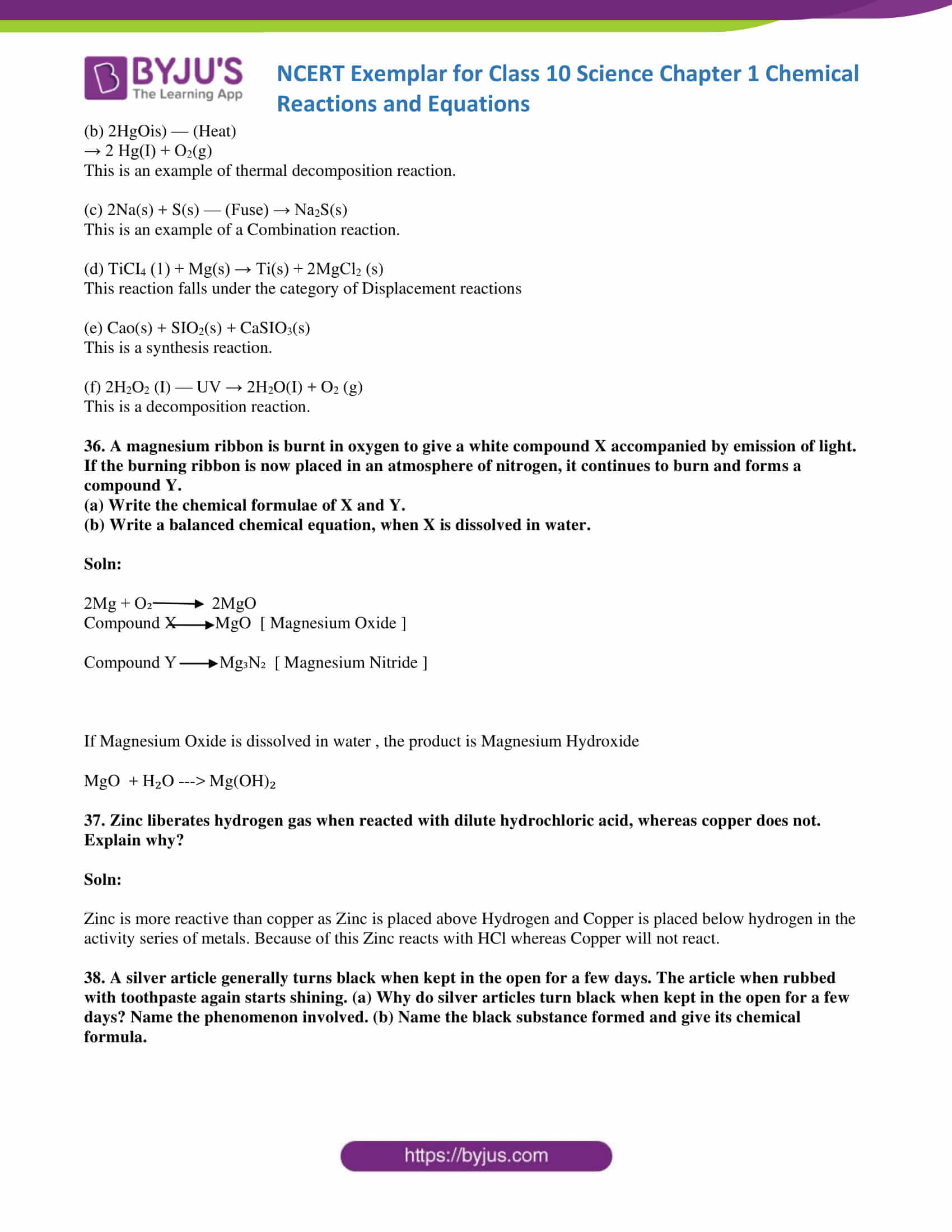

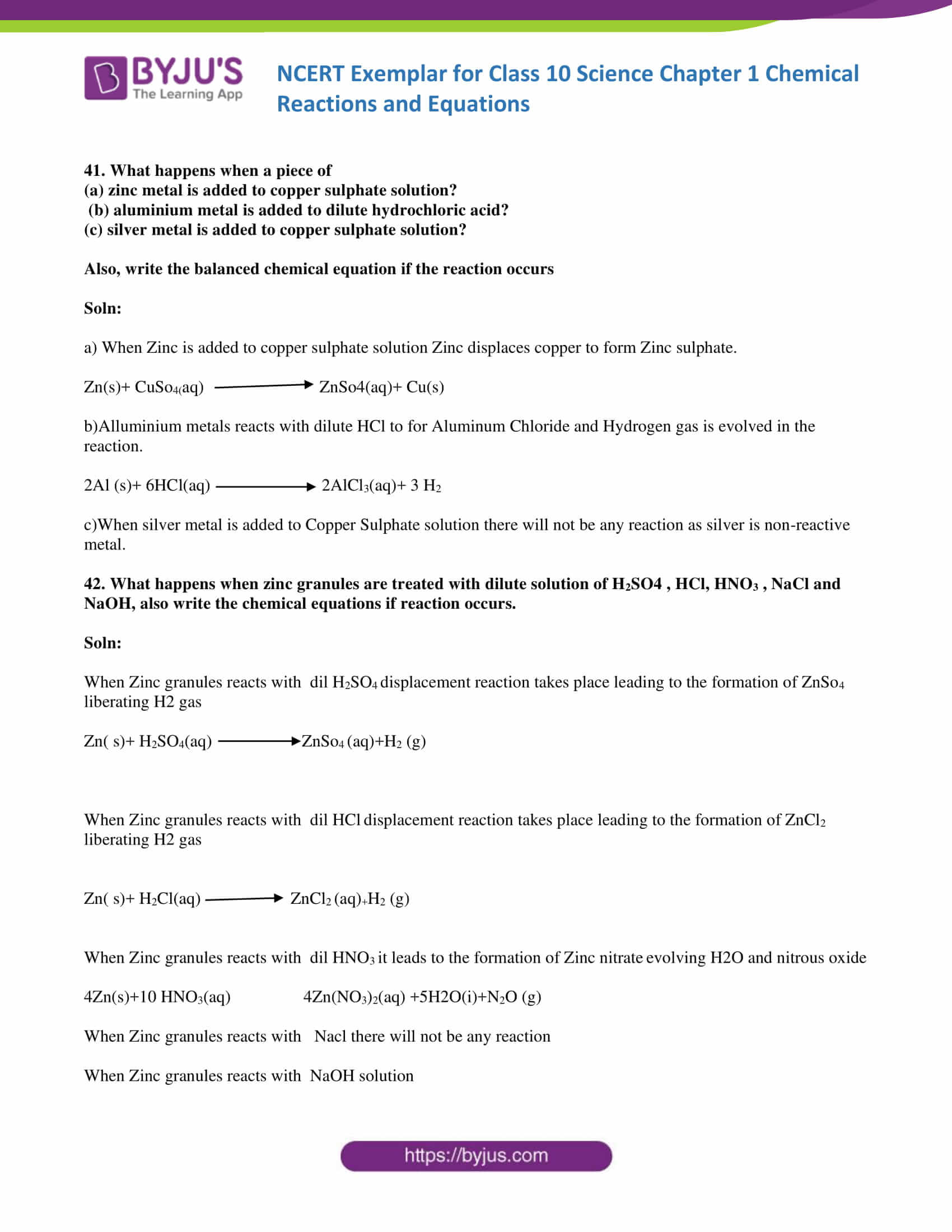
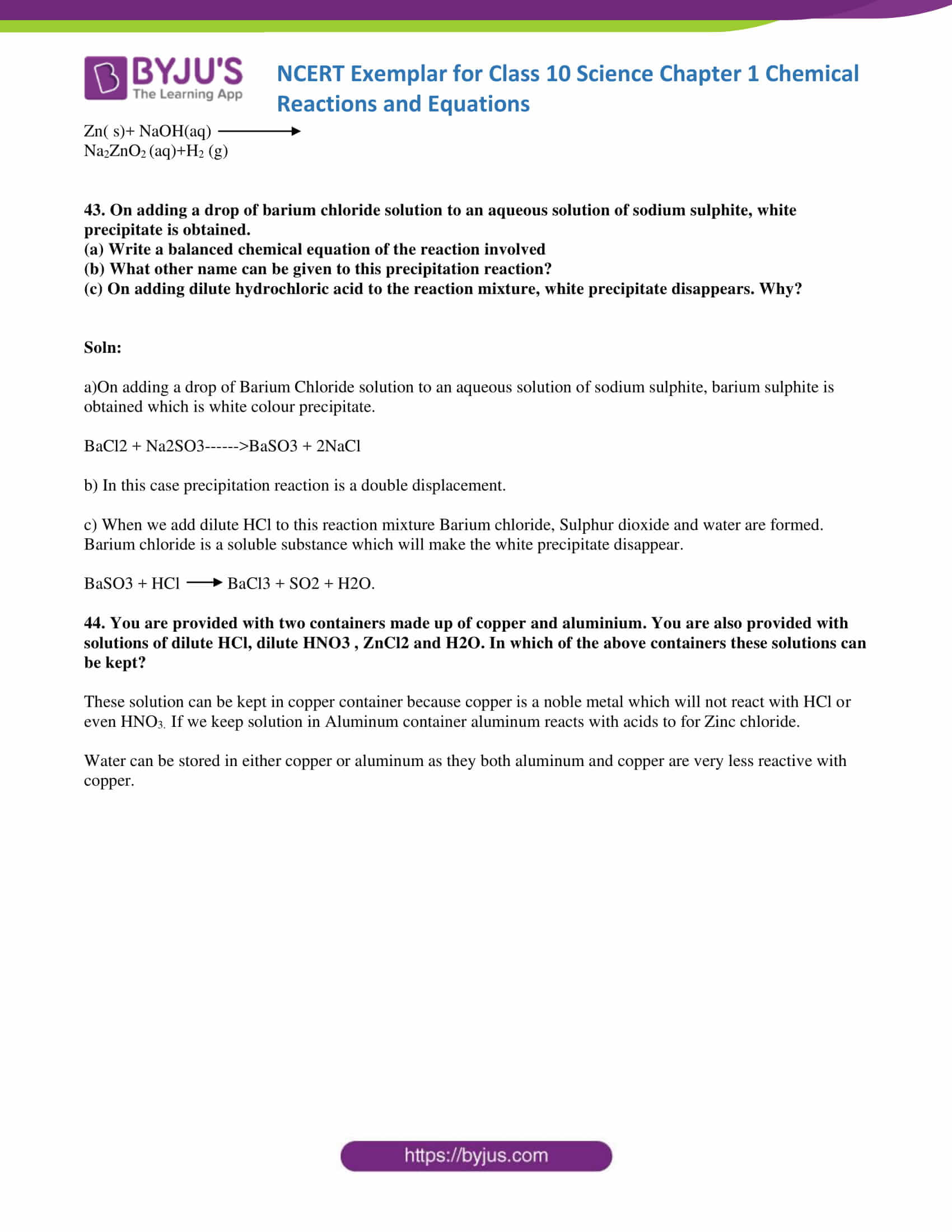

Comments